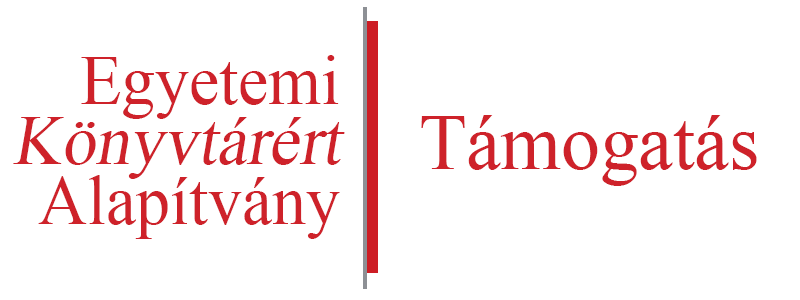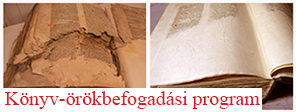Patterson and Károlyi collections
Document type:
Keywords:
Patterson and Károlyi collections: the old books of high value hold Ex Libris or reference as to their owner. The Collection is located in the office of the Director of ELTE’s English-American Institute, access to the collection is limited. A short biography of the owners of the books follows, source: József Szinnyei: The life and works of Hungarian writers (“Magyar írók élete és munkái”), volumes X and V, Budapest. (1905 and 1897)
1. Arthur, philologist, born in London on 7 June, 1835, raised in family until the age of 18, entered the University of Cambridge in 1855, where he was capped doctor in 1859. This is when his work titled An Indian Castle (London 1860) was published, which won the prize novel award of the Cambridge University. He traveled Hungary many times between 1862-67, learned the Hungarian language and studied our relations in detail. His first report on Hungary, titled Hungarian Election was published in 1866 in the Fortnightly Review and its success convinced him to publish a more extensive work titled The Magyars, their country and institutions (London 1869). Furthermore, he translated Jókai’s novel The new landlord, 1869 (“Új földesúr”) and Gyulai’s novel The last master of an old manorhouse, Cornhille Magazine 1872 (“Egy régi udvarház utolsó gazdája”). From 1886 he is an exceptional teacher of the English language and literature at the university of Budapest; external member of the Kisfaludy association and the Hungarian Academy of Science. Other works: Report on recent Hungarian Philology (Philol. Soc. 1884); English grammar and reading book (Budapest 1892, with József Balassa); furthermore, a number of his dissertations regarding Hungarian literature and relations was published in the English journals: Academy, Fortnightly Review, Journal of Education and Macmillan's Magazine.
Sándor Károlyi (I.), the first to hold the title of count in his family, son of László from Erzsébet Sennyey, born on 20 March, 1668, died on 8 Sept., 1743, successor of his father as “Főispán” of the County of Szatmár, Baron of the Upper-Hungarian central court of justice from 1699, and important and powerful role model in all stages of his life both in civil, political and military affairs and official and family matters. In 1703, at the beginning of Ferenc Rákóczi’s War for Independence he is the first to defeat the uprising Kuruc at Dolha. However, due to his well-known loyalty toward his nation and his country’s constitution, which was found incompatible with loyalty and fidelity toward the emperor in Vienna, as well as the secret intrigue and suspicion against him, he lost the confidence of the court, hence he fled to the army of Rákóczi and became one of Rákóczi’s most mighty party leaders, member of the military council and head general. However after the Battle of Romhány, convinced that continuing the war was impossible due to the great general fatigue and that the blood of the nation was not to waste with no hope of winning: he took great part in negotiating and concluding peace at Szatmár. Following peacemaking, he was lavished with favours by the court of Vienna. First on 15 Sept. 1711 he was appointed deputy head warlord by Eleonora, widow empress, then again on 12 Jan. 1712 by the new emperor and king, Károly III, was also made earl on 5 April.; was entrusted to calm certain posterior Kuruc movements in 1719; was sent to represent the king at the parliamentary meeting of 1723 in a number of important national issues and on 12 Sept. of the same year he was honored secret councilor, on 4. Oct was made general of the horse troops as recognition of his military excellence, on 5 Jan. 1724 was appointed member of the organized lieutenant council and head director of the province’s committee; established a permanent horse regiment to protect the country, in 1734 and was made leader of the regimen, also sending his only son, Ferenc with his regimen to fight the battle at Rajna; he was trusted with leading the armies of the uprising nobles in the Trans-Tisza region in 1741 and on 24. Sept. of the same year Maria Theresa made him marshal, the highest military position of the time. Reaching the highest positions and influence, he explicitly and consistently used this position - which brought much suspicion upon his loyalty to the country - to assist the helpless Kuruc, obtaining permissions for foreign fugitives to return to their homelands, protecting and supporting those in need. He spent large amounts on the establishment and support of charity organizations, churches and schools and left brilliant monuments behind, just like a true, noble Hungarian lord and fatherly benefactor of his serfs. He established the church and shared residence of the order’s convent, as well as hospital for the poor in Nagy-Károly, the nunnery of the Poor Clares in Pest, the order house of the Conventual Franciscans in Báthor and Miskolc, as well as the churches and schools of Majthény, Csenger, Kaplony, Erdőd, etc. He also raises his children to represent the virtues of love of the nation, local customs and pure morals. He bows in respect for women....marries Krisztina Sáky, the daughter of Earl Csáky, who fled with Rákóczi; he marries his daughter Klára off to the also Kuruc Gábor Haller. A true and detailed presentation of his political role is still to be made, however there is no doubt as to his loyal nationalism and his noble human- and family- character, also proven by his acts and honestly formulated principles in his letters.
Earl Sándor Károlyi (II.), son of István and his second wife, Countess Franciska Esterházy, congressman, secret councilor, excellent lord and political economist, born on 10 Nov., 1831. With the start of the War for Independence, he joined the Károlyi cavalry regiment founded and equipped by his father and fought as head lieutenant on the side of General Klapka. Following the repression of the independence he went to Paris and only returned home to manage his farm after the general amnesty was granted, and devoted all his time to economic studies. Meanwhile, he took active part in the life of the national economic league, as its work and sphere of influence was expanding, took a leading part at the farmers’ congress of 1879, later one of the founding members of the circle of farmers, a determining factor in the reorganization of the Tisza-regulating committee and later chairman of its board. He was first elected congressman in 1881 from the Tasnád district of Szilágy county and represented the liberal party at the congress this year, however in the elections of 1884 he proposed the program of the conservative opposition, which was elected by the voting district of Eszterháza. He was honored the position of chairman of the international farmers’ congress in 1885, during the national expo. Following the steps of his father, he became one of the presidents of the Saint Stephen Association. He was dignified true private secret councilor in 1882. He also appeared as author in the field of national economy and issued a valuable study both in the periodical called “Nemzetgazdasági Szemle” and in a special script, titled Our agricultural export and waterways. He married the widow of his dead older brother Earl Ede K., Countess Klarissza Kornis. His portrait was published as a drawing of Marastoni in the 18th issue of the “Ország Tükre” in 1862.
Additional literature related to the Patterson collection:
Frank Tibor, "Bibliothèque du Comte Etienne Károlyi. A fóti kastélytól az Angol Tanszékig". In: Ittzés Gábor, Kiséry András, szerk., Míves semmiségek/Elaborate trifles: Tanulmányok Ruttkay Kálmán 80. születésnapjára (Piliscsaba: Pázmány Péter Katolikus Egyetem, 2002), pp. 349-356. (Pázmány Papers in English and American Studies; 2.)
Tibor Frank, "Arthur J. Patterson and the Austro-Hungarian Settlement of 1867," in: László Péter and Martin Rady, eds., British-Hungarian Relations Since 1848 (London: Hungarian Cultural Centre/School of Slavonic and East European Studies, University College, London, 2004), pp. 47-62;
Tibor Frank, Picturing Austria-Hungary: The British Perception of the Habsburg Monarchy 1865-1870 (Boulder, CO: Social Science Monographs--New York: Columbia University Press, 2005), pp. 109-119.
Frank Tibor, "Arthur J. Patterson és a The Magyars," In: Háda Béla, Ligeti Dávid Ádám, Majoros István, Maruzsa Zoltán, Merényi Krisztina, Petneházi Margit, szerk., Eszmék, forradalmak, háborúk: Vadász Sándor 80 éves (Budapest: ELTE Új- és Jelenkori Egyetemes Történeti Tanszék, 2010), pp. 141-153.
Keresés
Szín
Alapítvány
Chat
Egyetemi Könyvtárért Alapítvány
Chat
vodkát akarok!!!!! :D
2019.02.08. 13:01
Vodkát nem tartunk a könyvtárban, de például az Egyetemi Könyvtár közelében számos vendéglátóhely található. :)
Tisztelt Könyvtár Szolgálat! A SciFinder adatbázis elérésével kapcsolatban érdeklődöm. Egyetemi hálózatról próbáltam belépni, a bejelentkezéshez caesar azonosítót és jelszót megadva, de nem működött. Hogy tudnám a legegyszerűbben elérni az adatbázist?
2019.03.22. 14:39
Köszönjük az üzenetet! Kollégáink igyekszenek minél hamarabb elhárítani a problémát, 1-2 nap türelmet kérünk.
???
2019.04.16. 13:51
Látogatójeggyel is van lehetőség az Arcanum Digitális Tudománytáron megnézni a digitalizált folyóiratokat?
2019.04.17. 11:45
Kedves Érdeklődő!
Igen, gépeinken szabad a hozzáférés az Arcanum adatbázisaihoz.
Is it free to use the library space and wifi for general public?
2019.06.13. 10:34
Yes, you can use our library and the services free with a visitor's pass which you can get to information desk on ground floor.
Send message, Previous messages
Keresés





